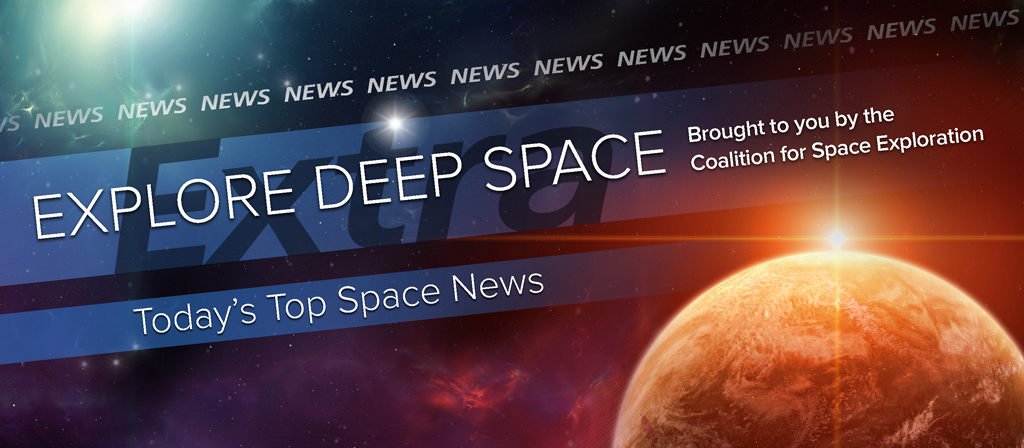Today’s Deep Space Extra offers the latest reporting and commentary on space related activities from across the globe. NASA Administrator Charles Bolden talks human deep space exploration. NASA’s Lunar Reconnaissance Orbiter solves Apollo 16 mystery. The French space agency vows to unravel vacuum leak that delayed NASA’s next Mars lander mission by two years. Increased NASA funding for 2016 will advance work on WFIRST, a future space telescope. Commercial missions plan to place bits of Earth history on the lunar surface. A physicist/author ponders existence before the big bang. U.S. federal courts assigned responsibility for resolving commercial space disputes. Florida space launches surged in 2015. Recent U.S. rocket landings open a door to launch vehicle re-use and possible cost savings.
Human Deep Space Exploration
NASA Administrator Charles Bolden talks to WHNT News 19
WHNT News 19, of Huntsville, Ala. (1/4): “I’m a happy camper,” says NASA Administrator Charles Bolden in an interview that looks to the role NASA’s Marshall Space Flight Center plays in efforts to transition’s the agency’s low Earth orbit activities to human deep space exploration.
Moon mystery solved! Apollo rocket impact site finally found
Space.com (1/4): NASA’s eagle eyed Lunar Reconnaissance Orbiter has spotted the long sought impact site of the Saturn S-IVB rocket stage for the April 1972 Apollo 16 mission. Contact with the 3rd stage of the massive Saturn 5 rocket was lost as it neared the lunar surface.
Unmanned Deep Space Exploration
CNES vows to get to the bottom of leaks that forced Mars InSight delay
Space News (1/4): Officials of the French space agency, CNES, vowed Monday to get to the bottom of the vacuum leaks that have hobbled an ultra-sensitive seismometer assigned to the NASA-led InSight Mars lander mission planned for a March lift off. A series of leaks have prompted NASA to cancel the 2016 launch in order to establish a root cause. A launch in May 2018 is possible, if experts can resolved the matter within budgets.
NASA has begun working on its next great space observatory
Ars Technica (1/4): A 2016 spending increase permits NASA to begin work on a future space observatory, WFIRST, in 2016, a year earlier than planned. The telescope, which will include components donated by the U.S. National Reconnaissance Office and a coronagraph, will study planets circling other stars.
An artistic time capsule prepares to hitch a ride to the Moon
National Public Radio (1/4): The Moon Ark, part of a Google X-Prize endeavour to reach the Moon with robotic spacecraft, has room for a time capsule that among other ventures will feature samples of water from the world’s major rivers and the blood of artists.
What came before the big bang?
Washington Post (1/4): MIT physicist and novelist Alan Lightman ponders existence 14 billion years ago, or shortly before the big bang on a cosmic scale.
Commercial to Low Earth Orbit
Jurisdiction of the federal courts: An under-appreciated provision of the Commercial Space Launch Competitiveness Act
The Space Review (1/4): The new Commercial Space Launch Competitiveness Act places exclusive jurisdiction over third party claims as well as those by space flight participants resulting from death, bodily injury, or property damage or loss resulting from an activity carried out under FAA spaceflight licensing with the federal courts. That may come as a surprise going forward, writes Michael J. Listner, founder and principal of Space Law & Policy Solutions. The legislation, perhaps best known for granting ownership rights to citizens who recover resources on asteroids and other planetary bodies, was signed into law on Nov. 25.
Florida spaceport tallies highest launch rate in more than a decade
Spaceflightnow.com (1/4): Florida’s Cape Canaveral hosted 17 orbital launches in 2015, the most since 2003.
Increasing the profit ratio
The Space Review (1/4): Recent demonstrations of rocket landings, first Blue Origin with the suborbital New Shepard then SpaceX with the orbital Falcon 9, have raised new optimism for lower launch costs through launch vehicle re-use. Essayist Sam Dinkin suggests the actual outcome could take years to assess. Some of the issues include the robustness of the hardware, costs to refurbish and fuel launch vehicles as well as the match between lower costs and increased demand.

